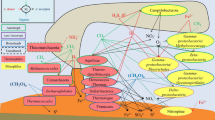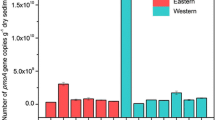Abstract
The hyper-alkaline, high-Ca2+ springs of Maqarin, Jordan, were investigated as an analogue for various microbial processes at the extremely high pH generated by cement and concrete in some underground radioactive waste repositories. Leaching of metamorphic, cementitious phases in Maqarin has produced current, hyper-alkaline groundwater with a maximum pH of 12.9. Six consecutive expeditions were undertaken to the area during 1994–2000. The total number of microorganisms in the alkaline waters was 103–105 cells/ml. Analysis of the 16S-ribosomal ribonucleic acid (rRNA) diversity revealed microorganisms mainly belonging to the Proteobacteria. Obvious similarities between the obtained sequences and sequences from other alkaline sites could not be found. Numerous combinations of culture media compositions were inoculated with spring, seepage and groundwaters and incubated under aerobic and anaerobic conditions with various carbon sources. Assimilation studies were performed using identical radio-labeled carbon sources. Glucose seemed to be the preferred carbon source for assimilation, followed by acetate, lactate, and leucine. The results demonstrate that microorganisms from the hyper-alkaline springs of Maqarin could grow and be metabolically active under aerobic and anaerobic hyper-alkaline conditions. However, the growth and activity found were not vigorous; instead, slow growth, low numbers, and a generally low metabolic activity were found. This suggests that microbial activity will be low during the hyper-alkaline phase of cementitious repositories.


Similar content being viewed by others
References
Alexander WR, Dayal R, Eagleson K, Eikenberg J, Hamilton E, Linklater CM, McKinley IG, Tweed CJ (1992) A natural analogue of high pH cement pore waters from the Maqarin area of northern Jordan. II. Results of predictive geochemical calculations. J Geochem Explor 46:133–146
Balashova VV, Zavarsin GA (1980) Anaerobic reduction of ferric iron by hydrogen bacteria. Microbiology 48:635–639
Barnes I, O’Neil JR, Trescares JJ (1978) Present day serpentinization in New Caledonia, Oman and Yugoslavia. Geochim Cosmochim Acta 42:144–145
Barnes I, Presser TS, Saines M, Dickson P, Van Goos AFK (1982) Geochemistry of highly basic calcium hydroxide groundwaters in Jordan. Chem Geol 35:147–154
Bath AH, Christofi N, Neal C, Philp JC, Cave MR, McKinley IG, Berner U (1987) Trace element and microbiological studies of alkaline groundwaters in Oman, Arabian Gulf: a natural analogue for cement pore waters. (Nagra technical report NTB 87–16) Nagra, Baden, Switzerland
Coombs P, Gardner SJ, Rochelle CA, West JM (1994) Microbial processes under hyperalkaline conditions: results from Phase III of the Maqarin natural analogue study. (Nagra internal report 94–37) Nagra, Wettingen, Switzerland
Duckworth AW, Grant WD, Jones BE, Van Steenbergen R (1996) Phylogenetic diversity of soda lake alkaliphiles. FEMS Microbiol Ecol 19:181–191
Ekendahl S, Pedersen K (1994) Carbon transformations by attached bacterial populations in granitic ground water from deep crystalline bed-rock of the Stripa research mine. Microbiology 140:1565–1573
Felsenstein J (1985) Confidence limits on phylogenies: an approach using bootstrap. Evolution 39:783–791
Felsenstein J (1989) PHYLIP: phylogeny inference package. Clade 5:164–166
Fredrickson JK, Fletcher M (2001) Subsurface microbiology and biogeochemistry. Wiley-Liss, New York
Grant WD, Mwatha WE, Jones BE (1990) Alkaliphiles, ecology, diversity and applications. FEMS Microbiol Rev 75:255–270
Hallbeck L, Pedersen K (1990) Culture parameters regulating stalk formation and growth rate of Gallionella ferruginea. J Gen Microbiol 136:1675–1680
Haveman SH, Pedersen K, Routsalainen P (1999) Distribution and metabolic diversity of microorganisms in deep igneous rock aquifers of Finland. Geomicrobiol J 16:277–294
Jones BE, Grant WD, Duckworth AW, Qwenson GG (1998) Microbial diversity of soda lakes. Extremophiles 2:191–200
Keith-Roach MJ, Livens FR (2002) Interactions of microorganisms with radionuclides. Elsevier, Amsterdam
Khoury HN, Salameh E, Clark IP, Fritz P, Milodowski AE, Cave MR, Bajjali W, Alexander WR (1992) A natural analogue of high pH cement pore waters from the Maqarin area of northern Jordan. II. Introduction to the site. J Geochem Explor 46:117–132
Kimura M (1980) A simple method for estimating evolutionary rates of base substitutions through comparative studies of nucleotide sequences. J Mol Evol 16:111–120
Kostka J, Nealson KH (1998) Isolation, cultivation and characterization of iron- and manganese reducers. In: Burlage RS, Atlas R, Stahl D, Geesey G, Sayler G (eds) Techniques in microbial ecology. Oxford University Press, New York, pp 58–78
Marshall KC (1984) Microbial adhesion and aggregation. Springer, Berlin Heidelberg New York
Miller W, Alexander R, Chapman N, McKinley I, Smellie J (1994) Natural analogue studies in the geological disposal of radioactive waste. (Studies in environmental science 57) Elsevier, London
Milodowski AE (1996) A natural analogue study of the Maqarin hyperalkaline groundwaters: a draft report on hyperalkaline groundwater/rock interaction. (Nagra internal report 94–74) Nagra, Wettingen, Switzerland
Pedersen K (2001) Diversity and activity of microorganisms in deep igneous rock aquifers of the Fennoscandian Shield. In: Fredrickson JK, Fletcher M (eds) Subsurface microbiology and biogeochemistry. Wiley-Liss, New York, pp 97–139
Pedersen K, Ekendahl S (1990) Distribution and activity of bacteria in deep granitic groundwaters of southeastern Sweden. Microb Ecol 20:37–52
Pedersen K, Ekendahl S (1992a) Incorporation of CO2 and introduced organic compounds by bacterial populations in groundwater from the deep crystalline bedrock of the Stripa mine. J Gen Microbiol 138:369–376
Pedersen K, Ekendahl S (1992b) Assimilation of CO2 and introduced organic compounds by bacterial communities in ground water from southeastern Sweden deep crystalline bedrock. Microb Ecol 23:1–14
Pedersen K, Holmström C, Olsson A-K, Pedersen A (1986) Statistic evaluation of the influence of species variation, culture conditions, surface wettability and fluid shear on attachment and biofilm development of marine bacteria. Arch Microbiol 145:1–8
Pedersen K, Arlinger J, Hallbeck L, Pettersson C (1996) Diversity and distribution of subterranean bacteria in ground water at Oklo in Gabon, Africa, as determined by 16S-rRNA gene sequencing technique. Mol Ecol 5:427–436
Pedersen K, Arlinger J, Erlandson A-C, Hallbeck L (1997) Culturability and 16S rRNA gene diversity of microorganisms in the hyperalkaline groundwater of Maqarin, Jordan. In: Pedersen K (ed) Investigations of subterranean microorganisms and their importance for performance assessment of radioactive waste disposal. Results and conclusions achieved during the period 1995 to 1997. Swedish Nuclear Fuel and Waste Management, Stockholm, pp 239–262
Reasoner DJ, Geldreich EE (1985) A new medium for the enumeration and subculture of bacteria from portable water. Appl Environ Microbiol 49:1–7
Strunk O, Gross O, Reichel B, May S, Hermann S, Struckmann B, Nonhoff M, Lenke M, Vilbig A, Ludwig T, Bode A, Schleifer KH, Ludwig W (1998) ARB: a software environment for sequence data. Department of Microbiology, Technische Universität München, Munich
West JM, Deguelder C, Allen M, Breuetsch R, Gardner S, Ince S, Milodowski AE (1992) Microbial and colloidal populations in the Maqarin groundwaters. In: Alexander WR (ed) A natural analogue study of the Maqarin hyperalkaline groundwaters. I. Source term description and thermodynamic database testing. NAGRA Technical Report, Baden, pp 70–83
Wolin EA, Wolin MJ, Wolfe RS (1963) Formation of methane by bacterial extracts. Biol Chem 238:2882–2886
Acknowledgments
Hani Khoury and Elias Salameh, University of Jordan, Amman made this work possible due to the excellent organization of the expeditions. We would like to thank John Smellie for carefully reading and commenting on the manuscript. Proper English AB is acknowledged for proof-reading. The Swedish Nuclear Fuel and Waste Management Co, Stockholm, Sweden, financed this work.
Author information
Authors and Affiliations
Corresponding author
Additional information
Communicated by W.D. Grant
Rights and permissions
About this article
Cite this article
Pedersen, K., Nilsson, E., Arlinger, J. et al. Distribution, diversity and activity of microorganisms in the hyper-alkaline spring waters of Maqarin in Jordan. Extremophiles 8, 151–164 (2004). https://doi.org/10.1007/s00792-004-0374-7
Received:
Accepted:
Published:
Issue Date:
DOI: https://doi.org/10.1007/s00792-004-0374-7




